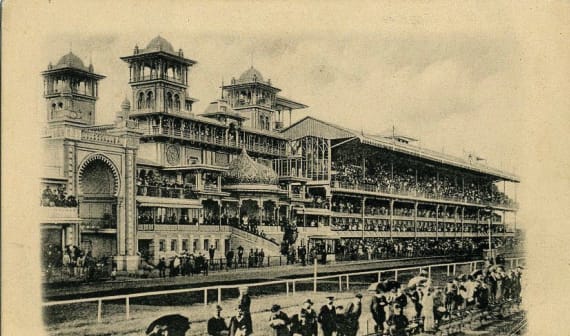
The Evolution of the Tote: From Manual Records to Machine Processing and Computer Programs
The tote, or parimutuel betting, is the simplest and most ancient system for wagering on events. The concept is that bets are pooled together, and after an event concludes, the organizer’s commission and taxes are deducted, with the remaining funds distributed among the winning bets proportional to their stake. Unlike bookmakers, there are no fixed odds, and players do not know their potential winnings until the event ends.
Initially, these were informal bets among a circle of friends or acquaintances at events. There were risks of the organizer disappearing with the funds.
In 1867, Joseph Oller, a Spanish entrepreneur living in Paris and co-founder of the famous Moulin Rouge cabaret, opened the first official betting office in Paris. The public welcomed this organized betting approach, leading to the opening of similar offices.
Initially, agencies opened at racecourses, followed by the introduction of mobile betting offices. Large boards (the totalisator board) displayed bets for each runner and the total pool size.
Calculations were done manually, slowing down winnings distribution and not guaranteeing accuracy. In 1880, New Zealand introduced the Eckler machine, resembling an arithmometer. Operated by a lever, it facilitated the counting of bets and prize payouts but struggled with large volumes.
Racecourses began constructing buildings for totes, with huge boards on the façade visible from afar. Operators accepted bets, processed data, and displayed it on the board. This was a coordinated effort throughout the race day, akin to a computer where the human factor was key.
The real revolution in gambling came with the first mechanical totalisator, invented by Australian engineer George Julius. Initially, he created a vote-counting machine for Western and Federal Australia's governments, which showed no interest.
Advised by a friend, he visited a racecourse and realized his machine could be adapted for tote calculations. George Julius spent years refining the mechanism in his Sydney garage, adapting it for racecourse use.
In 1913, the first automatic totalisator was installed at Ellerslie Stadium in Auckland, New Zealand. It displayed real-time odds for 30 horses, total bets on them, and the total bet sum. It was a massive machine occupying a three-story building, with the first floor for betting and the rest for the mechanism. The second floor housed a huge board showing runners' odds and placed bets.
The totalisator functioned like mechanical clocks, operated by heavy weights suspended on chains. Five years later, an improved electric model operated at Gloucester Park in Western Australia.
This marked the start of Auckland Totalisators Limited (ATL), supplying totes worldwide for 50 years.
In 1928, the first tote for dog racing was installed in the UK, and in 1932 in Florida. The largest was in Longchamp, Paris, serving up to 42 runners, connected to 300 ticket machines, and calculating multiple results – a remarkable technical achievement.
Mechanical installations functioned on racetracks worldwide until the 1970s, when electromechanical totes began to be replaced by computer systems.
Today, betting software is installed on computers, and totalisator boards (tote boards) are replaced by LCD displays. Many bookmakers have a tote, expanding offerings and providing more gaming opportunities to the clients
30 January 2024, 16:07
Articles
Why will the Snaitech deal double Flutter's market share in Italy?
26 September 2024, 16:00
Hiring Talent from Different Industries: Why and How?
26 September 2024, 09:09
The Social Casino Phenomenon: Real Money and Databases for Bookmakers
20 September 2024, 17:18
Dividing the Peruvian Pie: Who Will Take Over the Market After the Regulatory Law?
20 September 2024, 14:10
Expert Opinion: Why Betting Can't Survive Without AI Analysis of Sports Data
13 September 2024, 11:00
Finnish Gambling Market Reform: Veikkaus Resurgent vs Kindred's Leadership
10 September 2024, 19:00
Other news
Gambling adverts during football matches triple in UK
29 September 2024, 16:17
Merkur Group founder to step down as chairman after 67 years at the helm
29 September 2024, 09:22
Dutch players demand bookmakers refund their money
28 September 2024, 15:14
Flutter Enters Top 3 Largest Bookmakers in Brazil
28 September 2024, 10:08
DraftKings to Pay $200,000 Fine Over Social Media Post
27 September 2024, 15:41
Star Entertainment Group Reports Financial Downturn
27 September 2024, 10:54
Norfolk casino project approved by Architectural Review Board
26 September 2024, 14:37
Flutter Entertainment aims to triple profits
26 September 2024, 09:19
Five social casino ads banned in UK
25 September 2024, 10:27
Brazil's WA.Technology Acquires Onseo
24 September 2024, 17:24
ESPN Bet Could Launch in New York by Weekend
24 September 2024, 08:30
EveryMatrix Appoints Former Entain Employee as Product Director
23 September 2024, 17:03
Articles
Why will the Snaitech deal double Flutter's market share in Italy?
26 September 2024, 16:00
Hiring Talent from Different Industries: Why and How?
26 September 2024, 09:09
The Social Casino Phenomenon: Real Money and Databases for Bookmakers
20 September 2024, 17:18
Dividing the Peruvian Pie: Who Will Take Over the Market After the Regulatory Law?
20 September 2024, 14:10
Expert Opinion: Why Betting Can't Survive Without AI Analysis of Sports Data
13 September 2024, 11:00